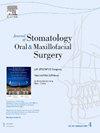Study on the repair function of radiation-induced salivary gland injury using human amniotic mesenchymal stem cells pre treated with hypoxia
IF 1.8
3区 医学
Q2 DENTISTRY, ORAL SURGERY & MEDICINE
Journal of Stomatology Oral and Maxillofacial Surgery
Pub Date : 2025-01-10
DOI:10.1016/j.jormas.2025.102223
引用次数: 0
Abstract
Objective
To investigate the reparative effect of hypoxia pretreated hAMSCs on radiation-induced damage to salivary gland function in mice.
Methods
hAMSCs were separated from human amniotic tissues by mechanical and enzymatic digestion methods and a 15 Gy electron beam was used to locally irradiate the neck of mouse to create a salivary gland injury model. The mouse models were randomly divided into four groups: control group, IR+PBS group, IR+Nor group and IR+HP group.
Result
Two months after hAMSCs injection, the saliva flow of mice in the IR+PBS group was significantly lower than that of the control group (P < 0.05). The saliva flow of mice in the IR+Nor group and IR+HP group were significantly increased compared to the IR+PBS group (P < 0.05). The cell apoptosis rate of the IR+PBS group was sensibly higher than that of the blank control group (P < 0.05). The cell apoptosis rates of the IR+Nor group and the IR+HP group were lower than that of the IR+PBS group. In addition, the apoptosis rate of the IR+HP group was lower than that of the IR+Nor group (P < 0.05). The changes of IOD of α-Amy in each group showed that the expression of α - Amy in the IR+PBS group was significantly lower than that in the blank control group (P < 0.05). Compared with the IR+PBS group, the IR+Nor group and the IR+HP group showed an obvious increase in the expression of α-Amy (P < 0.05).
Conclusion
Low oxygen pretreatment of hAMSCs could more effectively repair the function of radiation-induced salivary gland compared to normoxic cultivation.
缺氧预处理人羊膜间充质干细胞修复辐射性唾液腺损伤功能的研究。
目的:研究缺氧预处理的 hAMSCs 对小鼠唾液腺功能辐射损伤的修复作用:方法:采用机械和酶解方法从人羊膜组织中分离出hAMSCs,用15 Gy电子束局部照射小鼠颈部,建立唾液腺损伤模型。小鼠模型随机分为四组:对照组、IR+PBS组、IR+Nor组和IR+HP组:结果:注射 hAMSCs 两个月后,IR+PBS 组小鼠的唾液流量明显低于对照组(PC 结论:IR+PBS 组小鼠的唾液流量明显低于对照组(PC):与常氧培养相比,低氧预处理 hAMSCs 能更有效地修复辐射引起的唾液腺功能。
本文章由计算机程序翻译,如有差异,请以英文原文为准。
求助全文
约1分钟内获得全文
求助全文
来源期刊

Journal of Stomatology Oral and Maxillofacial Surgery
Surgery, Dentistry, Oral Surgery and Medicine, Otorhinolaryngology and Facial Plastic Surgery
CiteScore
2.30
自引率
9.10%
发文量
0
审稿时长
23 days
 求助内容:
求助内容: 应助结果提醒方式:
应助结果提醒方式:


